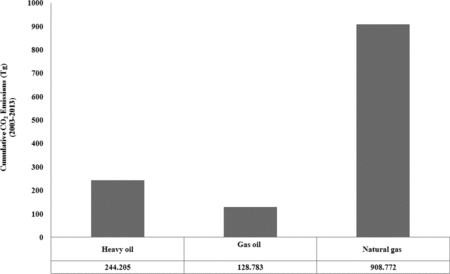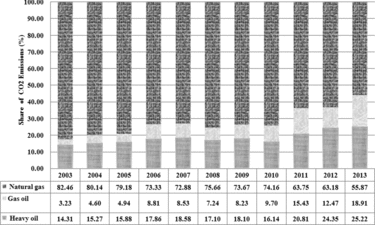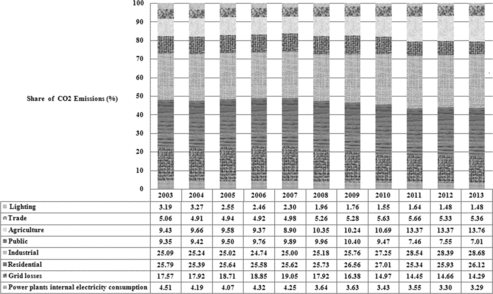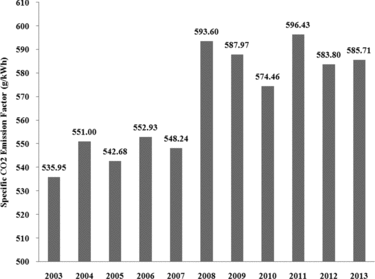Figures & data
Figure 1. Electricity generation in Iran's power sector by different sources (between 2003 and 2013) [Citation107].
![Figure 1. Electricity generation in Iran's power sector by different sources (between 2003 and 2013) [Citation107].](/cms/asset/087e41e2-90db-4c68-9eb6-1b60690af55f/tcmt_a_1090317_f0001_b.gif)
Figure 2. Trend of electricity consumption in residential, industrial and agriculture sectors (this study; [Citation107]).
![Figure 2. Trend of electricity consumption in residential, industrial and agriculture sectors (this study; [Citation107]).](/cms/asset/0d524131-7be1-480f-b983-874184e0b0b6/tcmt_a_1090317_f0002_b.gif)
Figure 3. Trend of electricity consumption in public, trade and lighting sectors (this study; [Citation107]).
![Figure 3. Trend of electricity consumption in public, trade and lighting sectors (this study; [Citation107]).](/cms/asset/f0fe4c9f-82e4-4061-9cc4-d0dbbfb0dda5/tcmt_a_1090317_f0003_b.gif)
Figure 4. Trend of grid losses and internal electricity consumption of power plants (this study; [Citation107]).
![Figure 4. Trend of grid losses and internal electricity consumption of power plants (this study; [Citation107]).](/cms/asset/575af5c0-3fb1-43c7-8bac-bb673f2e7d6a/tcmt_a_1090317_f0004_b.gif)
Figure 5. Computation stages of CO2 emissions estimation (based on IPCC methodology [Citation108]).
![Figure 5. Computation stages of CO2 emissions estimation (based on IPCC methodology [Citation108]).](/cms/asset/5f3429a4-5f23-4535-9314-2bee9c2595c8/tcmt_a_1090317_f0005_b.gif)
Figure 6. CO2 emissions from Iran's power sector in comparison with Iran's total emissions (this study; [Citation105]). EIA: US Energy Information Administration.
![Figure 6. CO2 emissions from Iran's power sector in comparison with Iran's total emissions (this study; [Citation105]). EIA: US Energy Information Administration.](/cms/asset/4c0be237-162e-42cf-a085-0e6451a45d4c/tcmt_a_1090317_f0006_b.gif)
Figure 8. Cumulative CO2 emissions with respect to fossil fuels consumption for electricity generation in Iran (this study).

Figure 9. Share of CO2 emissions with respect to fossil fuels consumption for electricity generation in Iran (this study).

Figure 10. Cumulative CO2 emissions with respect to the electric energy consumption in Iran (this study).

Figure 11. Share of CO2 emissions with respect to the electric energy consumption in Iran (this study).

Table 1. Coefficients of STIRPAT model calculated using partial least squares regression (this study).
Figure 12. Trend of CO2 emissions in comparison with population size, gross domestic product per capita and electricity intensity (this study; [Citation107,Citation111,Citation112]).
![Figure 12. Trend of CO2 emissions in comparison with population size, gross domestic product per capita and electricity intensity (this study; [Citation107,Citation111,Citation112]).](/cms/asset/00e32e79-a580-4a40-8bfc-374f57f1d9e4/tcmt_a_1090317_f0012_b.gif)
Figure 13. Trend of CO2 emissions in comparison with electricity generation by natural gas, heavy oil, gas oil and summation of hydropower, renewable energies and nuclear energy (this study; [Citation107]).
![Figure 13. Trend of CO2 emissions in comparison with electricity generation by natural gas, heavy oil, gas oil and summation of hydropower, renewable energies and nuclear energy (this study; [Citation107]).](/cms/asset/9fccc59d-3844-4fb4-8d00-06ee69a685af/tcmt_a_1090317_f0013_b.gif)
Table 2. The average specific carbon dioxide emission factor and carbon dioxide intensity in Iran's power sector in comparison with their alternatives in Turkey and China (this study; [Citation119]).

